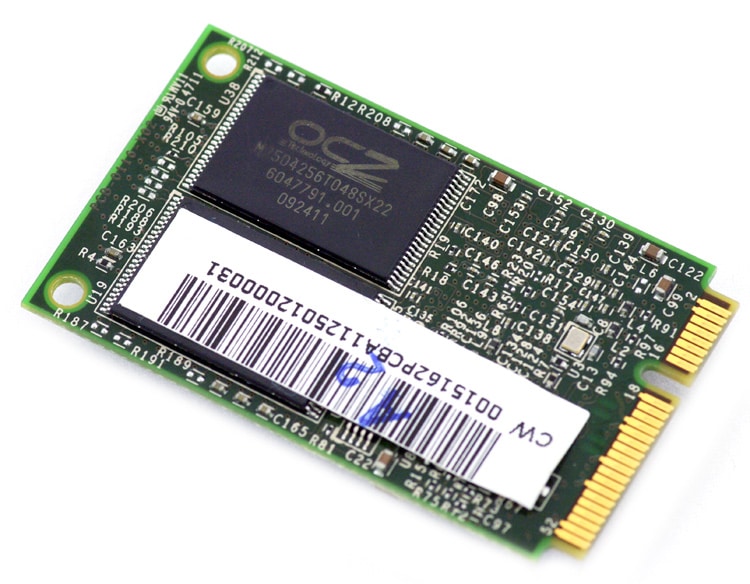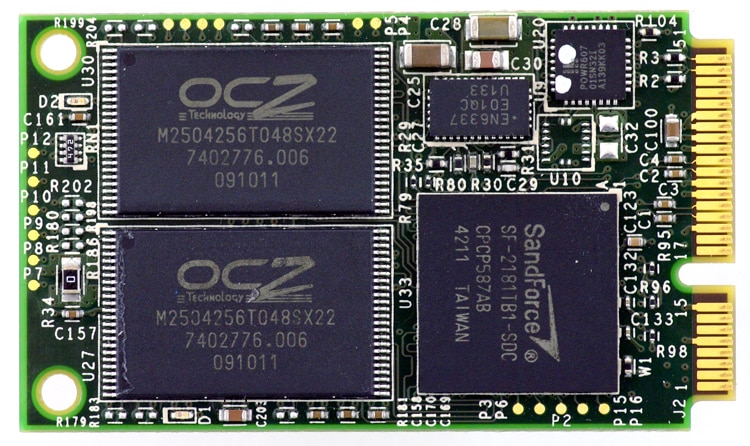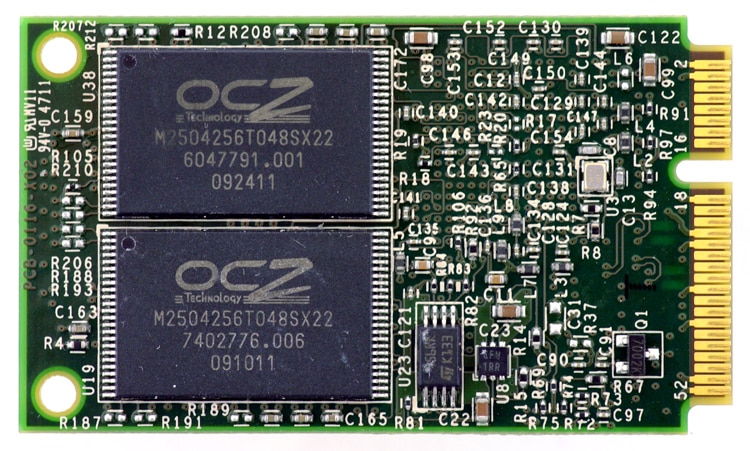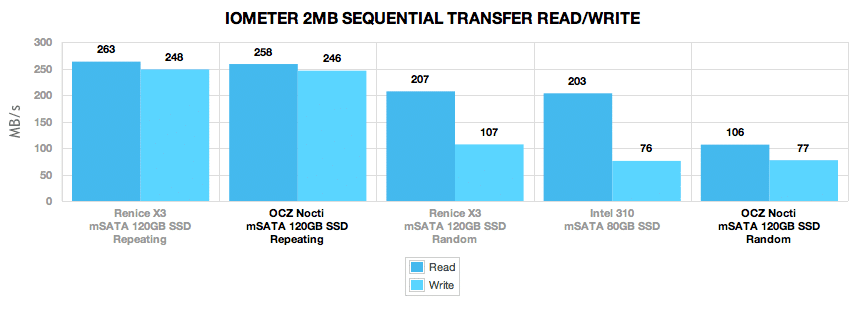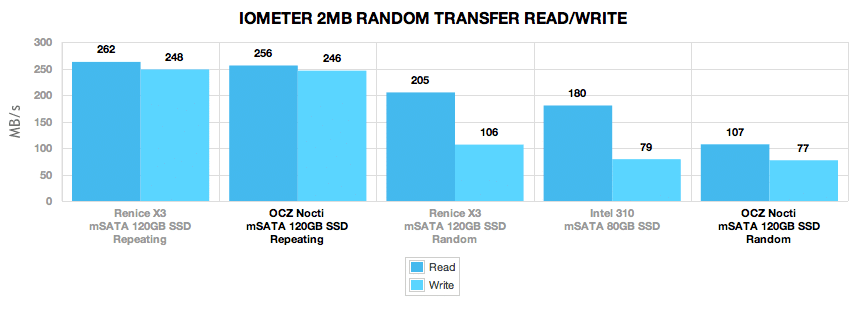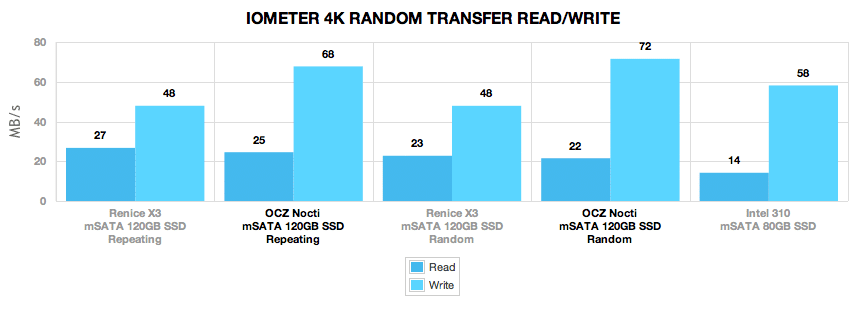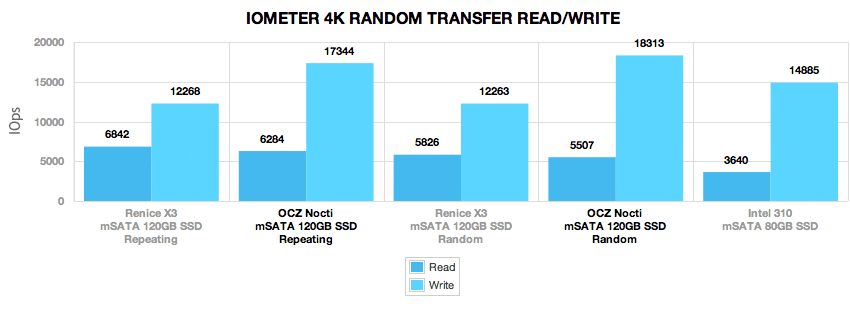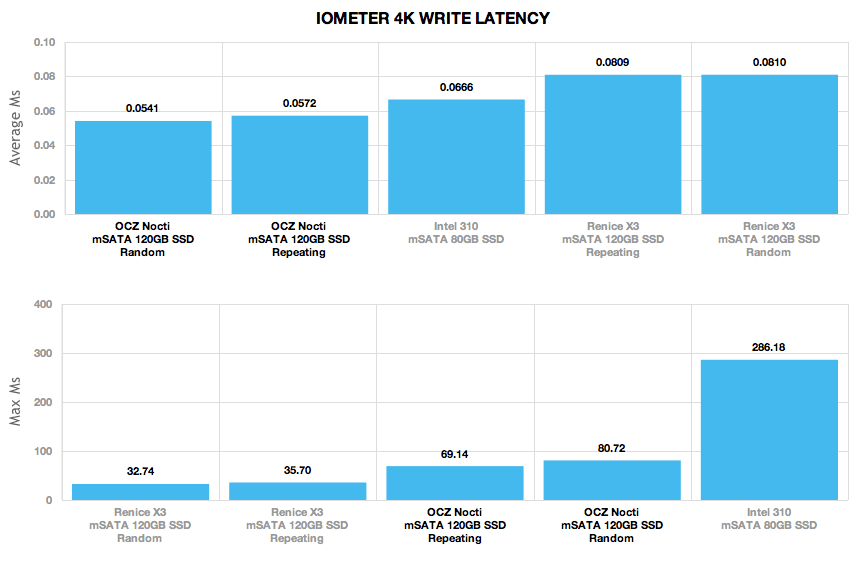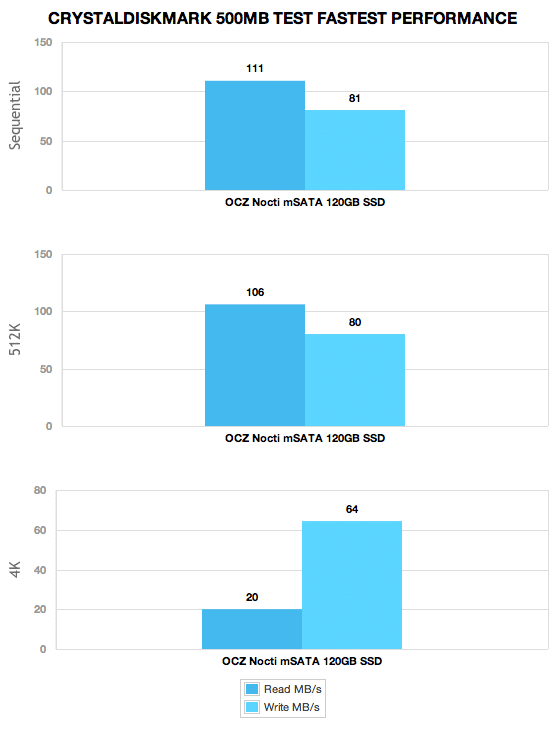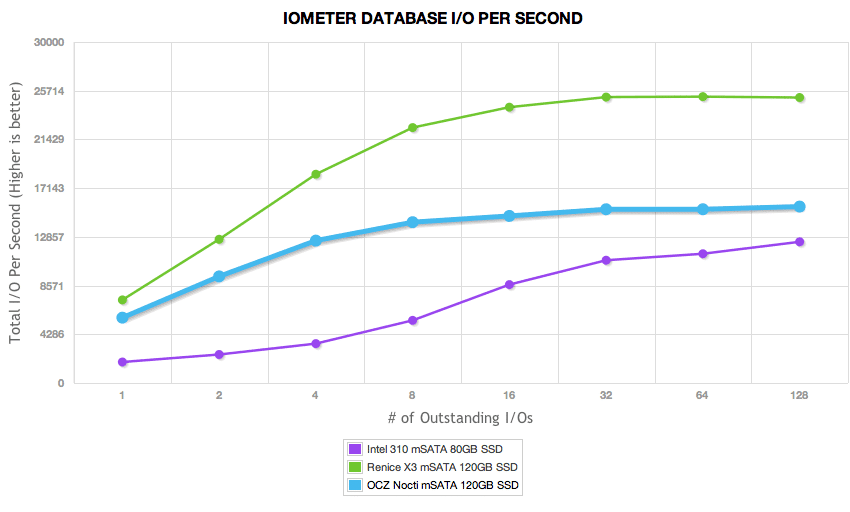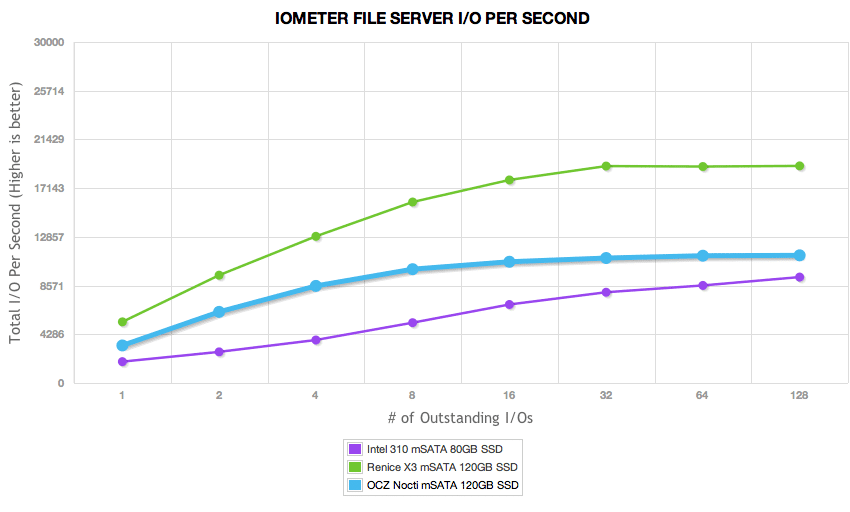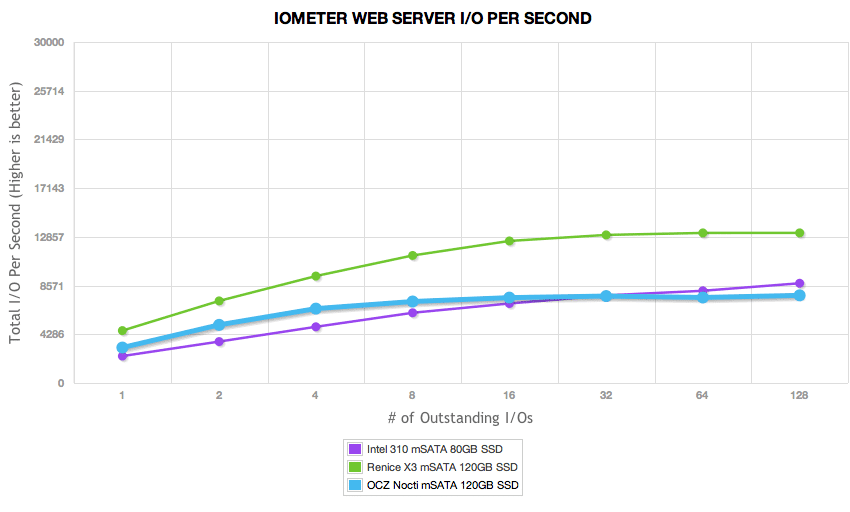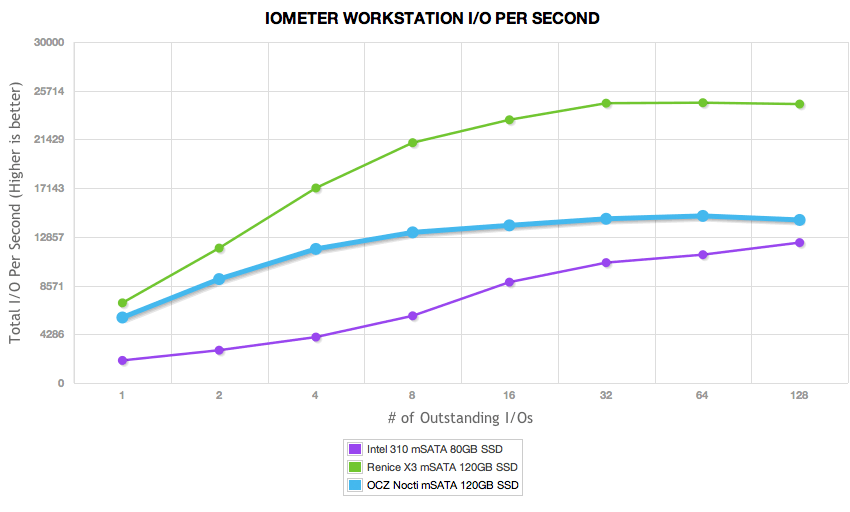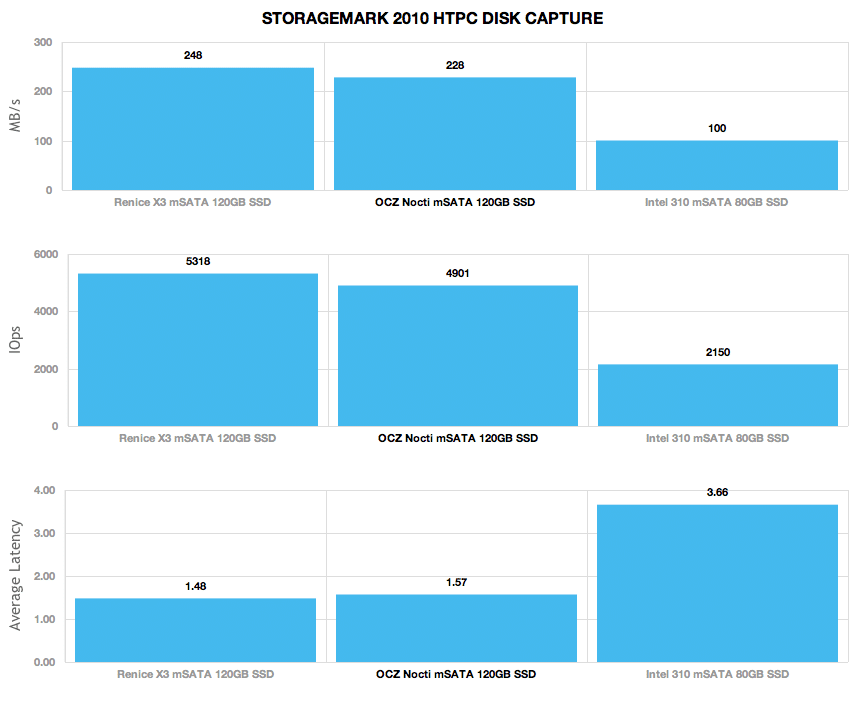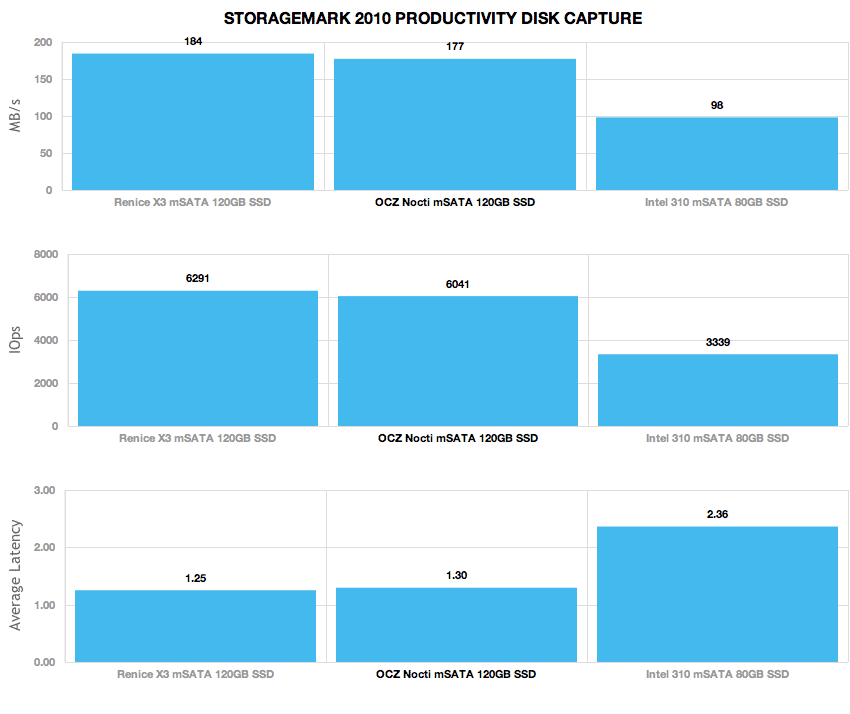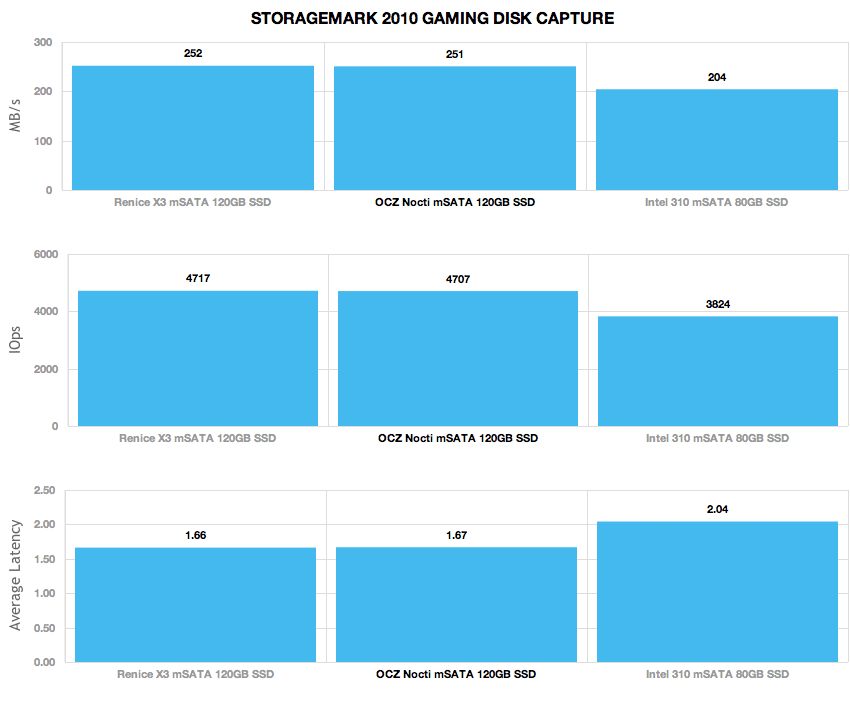OCZ’s mSATA SSDs have long been used in OEM and other specialized applications. mSATA SSDs are finding a much wider audience now though, as notebook, tablet and even desktop PC vendors are finding creative ways to use the diminutive in size, but not speed, SSDs. Whether used as a boot drive, primary storage or caching mechanism, the OCZ Nocti has quite a bit of flexibility. Available in capacities from 30GB to 120GB, the Nocti offers top-end performance of up to 280 MB/s read speeds, 260 MB/s writes and random write 4K IOPS of 32,500, essentially saturating the mSATA 3Gb/s interface speed.
OCZ’s mSATA SSDs have long been used in OEM and other specialized applications. mSATA SSDs are finding a much wider audience now though, as notebook, tablet and even desktop PC vendors are finding creative ways to use the diminutive in size, but not speed, SSDs. Whether used as a boot drive, primary storage or caching mechanism, the OCZ Nocti has quite a bit of flexibility. Available in capacities from 30GB to 120GB, the Nocti offers top-end performance of up to 280 MB/s read speeds, 260 MB/s writes and random write 4K IOPS of 32,500, essentially saturating the mSATA 3Gb/s interface speed.
The OCZ Nocti is built around the SandForce SF-2181 processor and OCZ-branded 2Xnm MLC NAND and is meant for both use with OEMs and for enthusiast upgrades. The Nocti is available in 30GB, 60GB and 120GB capacities with street prices of $75, $130 and $230 respectively, and the SSDs carry a three year warranty. OCZ offers other mSATA SSDs as well, the Devena 2 mSATA SSD is designed for OEM duty, while the OCZ Strata mSATA SSD was a lower-cost alternative based on an Indilinx controller that has recently been discontinued.
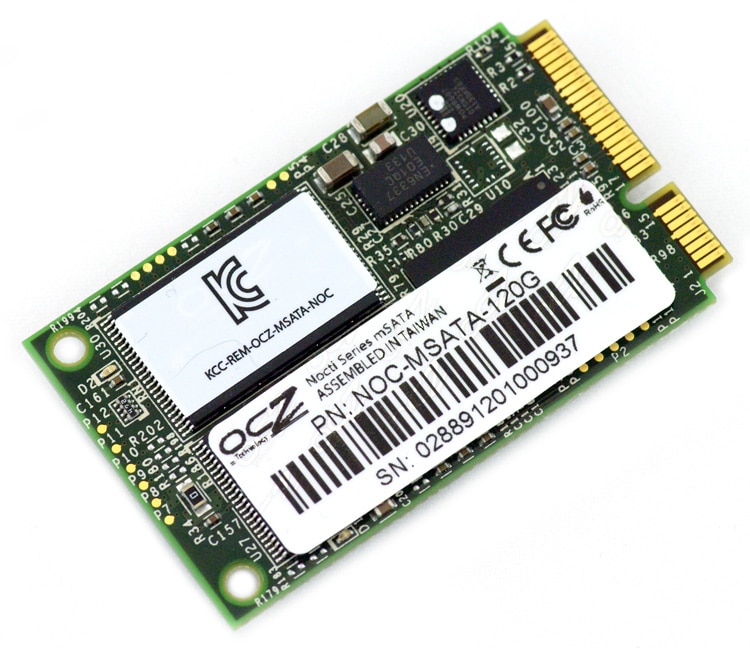
OCZ Nocti mSATA SSD Specs
- Available in 30GB to 120GB capacities
- 30GB: NOC-MSATA-30G
- Max Read: up to 280 MB/s
- Max Write: up to 255 MB/s
- Random Write 4k: 12,500 IOPS
- 60GB: NOC-MSATA-60G
- Max Read: up to 280 MB/s
- Max Write: up to 260 MB/s
- Random Write 4k: 12,500 IOPS
- 120GB: NOC-MSATA-120G
- Max Read: up to 280 MB/s
- Max Write: up to 260 MB/s
- Random Write 4k: 32,500 IOPS
- 30GB: NOC-MSATA-30G
- SandForce SF-2181 processor
- 2xnm MLC NAND
- Native TRIM support
- Seek Time: .1ms
- Dimensions – 30 x 50 x 3.5mm
- Weight – 6g
- Operating Temp – 0°C ~ 70°C
- Ambient Temp – 0°C ~ 55°C
- Storage Temp – -45°C ~ 85°C
- Power Consumption – 1.7W Active, 0.5W Idle
- MTBF – 2 million hours
- 3-Year Warranty
Aesthetics and Disassembly
The OCZ Nocti mSATA SSD doesn’t put any room to waste with its compact size. Measuring just 30mm x 50mm, this card is designed to fit inside the mSATA/mini-PCIe slots inside notebooks and some desktop motherboards to be used as a boot/cache drive. In notebooks such as the ThinkPad X220, ThinkPad T520, or ThinkPad W520 using an mSATA SSD leaves the primary 2.5-inch bay open for bulk storage.
At the heart of the Nocti mSATA SSD is a SandForce SF-2181 processor. It is a SATA 3.0Gb/s model, unlike its SF-2200 brother which interfaces at SATA 6.0Gb/s speeds. The primary reason for this, besides cost, is that many mSATA deployments are limited to SATA 3.0Gb/s speeds.
The Nocti uses four OCZ-branded 32GB (256Gb) 2xnm NAND pieces. OCZ branded NAND isn’t new, OCZ announced in October of last year that they had secured a bulk NAND buy as part of their plan to reduce overall drive costs, as well as extend the OCZ brand throughout certain SSDs. We saw the use of OCZ branded NAND in the OCZ RevoDrive Hybrid and suspect OCZ will use more of their own stamped NAND over time.
Synthetic Benchmarks
In our review of the 120GB OCZ Nocti, we show benchmarks against the 80GB Intel SSD 310, which uses an Intel controller, and the 120GB Renice X3 mSATA SSD, which is based on the prior-generation SandForce SF-1200 platform.
For the 120GB Nocti capacity, OCZ lists a peak read speed of 280MB/s and a write speed of 260MB/s. To put these claims to the test, we used our 2MB sequential transfer test in IOMeter.
With repeating data the OCZ Nocti mSATA SSD measured 258MB/s read and 246MB/s write, slowing to 106MB/s read and 77MB/s write with incompressible data.
Our next test looks at random 2MB transfers instead of sequential, showing what performance might look like during multiple file transfer requests.
Switching to random large-block transfers, the Nocti measured 256MB/s read and 246MB/s write with repeating data and 107MB/s read and 77MB/s write with incompressible data.
Moving on to even smaller transfer request sizes, our next section looks at random 4K read and write performance at a queue depth of one, and later moves to expanded queue depth tests.
While the Nocti showed some weakness in fast throughput speeds compared to the older generation Renice X3 with 3xnm NAND, it offered much faster QD=1 4K random write speeds, topping at 18,313 IOPS with incompressible data.
In our 4K write latency test, which measures access times at a queue depth of 1, the OCZ Nocti scored very well with average response times of 0.0541ms with incompressible data and 0.0572ms with compressible data. Peak latency times were also excellent, measuring 32.74ms and 35.7ms for repeating and randomized respectively.
Using CrystalDiskMark with randomized data, we noted similar read and write speeds as what we found with our incompressible IOMeter testing, although CDM did give slightly higher write speed figures.
Our last group of consumer IOMeter synthetic benchmarks looks at mixed-load server profiles including Database, Workstation, File Server, and Webserver. Looking at the performance of the OCZ Nocti with repeating data, it scored above the Intel SSD 310 but below the Renice X3.
Real-World Benchmarks
One thing we try to focus on with our reviews is how any given drive might perform under real-world conditions. For the average user, trying to translate random 4K write speeds into an everyday situation can be difficult. It helps when comparing drives in every setting possible, but it doesn’t exactly work out into faster everyday usage or better game loading times. For this reason we turned to our StorageMark 2010 traces, which include HTPC, Productivity, and Gaming traces to help readers find out how a drive might rank under their conditions.
The first real-life test is our HTPC scenario. In this test we include: playing one 720P HD movie in Media Player Classic, one 480P SD movie playing in VLC, three movies downloading simultaneously through iTunes, and one 1080i HDTV stream being recorded through Windows Media Center over a 15 minute period. Higher IOps and MB/s rates with lower latency times are preferred. In this trace we recorded 2,986MB being written to the drive and 1,924MB being read.
In a HTPC environment the OCZ Nocti slipped behind the Renice X3 slightly, but offered a massive boost in performance over the Intel mSATA SSD.
Our second real-life test covers disk activity in a productivity scenario. For all intents and purposes this test shows drive performance under normal daily activity for most users. This test includes: a three hour period operating in an office productivity environment with 32-bit Vista running Outlook 2007 connected to an Exchange server, web browsing using Chrome and IE8, editing files within Office 2007, viewing PDFs in Adobe Reader, and an hour of local music playback with two hours of additional online music via Pandora. In this trace we recorded 4,830MB being written to the drive and 2,758MB being read.
In our productivity trace, both the X3 and Nocti offered similar performance. Both drives far surpassed the Intel mSATA SSD.
Our third real-life test covers disk activity in a gaming environment. Unlike the HTPC or Productivity trace, this one relies heavily on the read performance of a drive. To give a simple breakdown of read/write percentages, the HTPC test is 64% write, 36% read, the Productivity test is 59% write and 41% read, while the gaming trace is 6% write and 94% read. The test consists of a Windows 7 Ultimate 64-bit system pre-configured with Steam, with Grand Theft Auto 4, Left 4 Dead 2, and Mass Effect 2 already downloaded and installed. The trace captures the heavy read activity of each game loading from the start, as well as textures as the game progresses. In this trace we recorded 426MB being written to the drive and 7,235MB being read.
In a read-intensive gaming environment, both SandForce-powered mSATA SSDs scored above 250MB/s average. The gap between these and the Intel mSATA SSD narrowed though, with the Intel measuring 204MB/s average.
Power
Applying the same read and write profiles that we performed at the beginning of this review, we measure the power used by the SSD during these read or write profiles. SandForce SSDs heavily rely on compression for faster speeds and less write amplification, as a result we measure power with both compressible and incompressible data.
OCZ listed an active power rate of 1.7W and an idle 0.5W. We measured above to the idle power rate through our interposer card with a measurement of 0.71 watts and our active tests ranged from 2 watts up to 2.95 watts with a constant 2MB sequential transfer of incompressible data.
Conclusion
The OCZ Nocti mSATA SSD does its intended job very well, delivering just about all the mSATA 3 Gb/s interface can handle with large sequential reads and writes, though it does struggle a bit with large-block transfers turning from compressible to incompressible data. On the random 4K side the Nocti posts very impressive write scores, easily besting the other mSATA comparables by a wide margin. The drive’s 4K latency is also the lowest in the group and the Nocti held up very well across the board in our real world traces.
For the enthusiast who wants to upgrade their system with an mSATA SSD, there are few options. This isn’t necessarily a bad thing though, as the Nocti provides an excellent blend of performance and price, along with the fact that it’s generally available in retail, where many boutique mSATA solutions are not. When we look at the Nocti head-to-head against the mainstream Intel SSD 310, the Nocti dominates on price, performance and capacity options.
Pros
- Better $/GB than Intel SSD 310 mSATA and faster speeds
- Easily available through multiple retail outlets
- Strong 4K random write speed
Cons
- Shows some weakness compared to SF-1200 and 3xnm-based mSATA offerings
- Not SATA 6Gb/s
Bottom Line
The OCZ Nocti mSATA SSD comes in capacities up to 120GB and delivers in two key areas – price and performance. In the mSATA space there aren’t many generally available options, but thankfully the Nocti is one of them. Those looking to take advantage of an mSATA SSD for caching, boot or the like will find the OCZ Nocti to be a worthy companion.


